15 STEM Titles To Celebrate Women
Elementary
BEATY, Andrea. Ada Twist, Scientist. illus. by David Roberts. 32p. Abrams. Sept. 2016. Tr $21.95. ISBN 9781419721373. 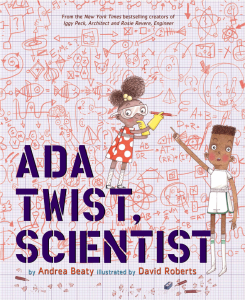 K-Gr 2–Ada Marie Twist is an inquisitive African American second grader and a born scientist. She possesses a keen yet peculiar need to question everything she encounters, whether it be a tick-tocking clock, a pointy-stemmed rose, or the hairs in her dad’s nose. Ada’s parents and her teacher, Miss Greer, have their hands full as the child’s science experiments wreak day-to-day havoc. On the first day of spring, the title character is tinkering outside her home when she notices an unpleasant odor. She sets out to discover what might have caused it. Beaty shows Ada using the scientific method in developing hypotheses in her smelly pursuit. The little girl demonstrates trial and error in her endeavors, while appreciating her family’s full support. In one experiment, she douses fragrances on her cat and then attempts to place the feline in the washing machine. Her parents, startled by her actions, send her to the Thinking Chair, where she starts to reflect on the art of questioning by writing her thoughts on the wall—now the Great Thinking Hall. Ada shines on each page as a young scientist, like her cohorts in the author’s charming series. The rhyming text playfully complements the cartoon illustrations, drawing readers into the narrative. VERDICT A winner for storytime reading and for young children interested in STEM activities. Pair with science nonfiction for an interesting elementary cross-curricular project.
K-Gr 2–Ada Marie Twist is an inquisitive African American second grader and a born scientist. She possesses a keen yet peculiar need to question everything she encounters, whether it be a tick-tocking clock, a pointy-stemmed rose, or the hairs in her dad’s nose. Ada’s parents and her teacher, Miss Greer, have their hands full as the child’s science experiments wreak day-to-day havoc. On the first day of spring, the title character is tinkering outside her home when she notices an unpleasant odor. She sets out to discover what might have caused it. Beaty shows Ada using the scientific method in developing hypotheses in her smelly pursuit. The little girl demonstrates trial and error in her endeavors, while appreciating her family’s full support. In one experiment, she douses fragrances on her cat and then attempts to place the feline in the washing machine. Her parents, startled by her actions, send her to the Thinking Chair, where she starts to reflect on the art of questioning by writing her thoughts on the wall—now the Great Thinking Hall. Ada shines on each page as a young scientist, like her cohorts in the author’s charming series. The rhyming text playfully complements the cartoon illustrations, drawing readers into the narrative. VERDICT A winner for storytime reading and for young children interested in STEM activities. Pair with science nonfiction for an interesting elementary cross-curricular project.
This review was published in the School Library Journal October 2016 issue.

![]() Burleigh, Robert. Solving the Puzzle Under the Sea: Marie Tharp Maps the Ocean Floor. illus. by Raúl Colón. 40p. bibliog. ebook available. glossary. websites. S. & S./Paula Wiseman Bks. Jan. 2016. Tr $17.99. ISBN 9781481416009.
Burleigh, Robert. Solving the Puzzle Under the Sea: Marie Tharp Maps the Ocean Floor. illus. by Raúl Colón. 40p. bibliog. ebook available. glossary. websites. S. & S./Paula Wiseman Bks. Jan. 2016. Tr $17.99. ISBN 9781481416009.
Gr 2-4 –In this excellent biography of scientist Marie Tharp, Burleigh, writing in the first person, allows this adept geologist and oceanographic cartographer to tell her own story. Map lover Tharp became one of the 20th century’s most important scientists, despite working in a field that greatly favored men. With fellow geologist Bruce Heezen, she mapped the world’s oceans. Colón’s signature softly hued, textured watercolors greatly enhance the text. One image depicts a research ship in the water upon which scientists took measurements called soundings to chart the ocean’s depth. The writing is accessible and immediate, and though Burleigh acknowledges that Tharp was a woman working in a man’s field, he casts her story in a happy light. A biographical page is appended, as well as thorough back matter. VERDICT A finely told, beautifully illustrated biography that saves a world class scientist from obscurity.
This review was published in the School Library Journal December 2015 issue.
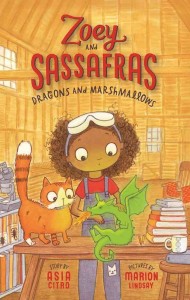 CITRO, Asia. Dragons and Marshmallows. illus. by Marion Lindsay. 96p. (Zoey and Sassafras: Bk. 1). glossary. Innovation. Mar. 2017. Tr $16.99. ISBN 9781943147083; pap. $5.99. ISBN 9781943147090. Gr 1-3–Zoey and her cat, Sassafras, love to explore, play pretend, and learn. They make an excellent team. Unfortunately, Zoey is feeling blue because her mom is leaving for a work conference. While her mom finishes packing, Zoey makes a big discovery: a photograph that glows purple, hidden amongst her mom’s papers. Zoey learns that magical animals come to the family’s barn when they need assistance. With her mom away, it is up to Zoey and Sassafras to aid a sick baby dragon. Zoey puts her Thinking Goggles to work as she researches how to help the dragon. The book relies heavily on STEM themes (Zoey creates an experiment, considers a hypothesis, and gathers evidence), but the story line does not suffer. Concepts are explained concisely and clearly, and a short glossary provides valuable vocabulary building. The slightly larger font makes the text inviting for emerging readers, and the illustrations blend perfectly into the story. Sassafras and the dragon prove to be able sidekicks in the vein of Disney characters, which will appeal to readers. An African American family takes center stage, something not often seen in early chapter books. VERDICT This book is a natural fit for STEM collections and deserves a place in all libraries serving young readers.–Sarah Wethern, Douglas County Library, Alexandria, MN
CITRO, Asia. Dragons and Marshmallows. illus. by Marion Lindsay. 96p. (Zoey and Sassafras: Bk. 1). glossary. Innovation. Mar. 2017. Tr $16.99. ISBN 9781943147083; pap. $5.99. ISBN 9781943147090. Gr 1-3–Zoey and her cat, Sassafras, love to explore, play pretend, and learn. They make an excellent team. Unfortunately, Zoey is feeling blue because her mom is leaving for a work conference. While her mom finishes packing, Zoey makes a big discovery: a photograph that glows purple, hidden amongst her mom’s papers. Zoey learns that magical animals come to the family’s barn when they need assistance. With her mom away, it is up to Zoey and Sassafras to aid a sick baby dragon. Zoey puts her Thinking Goggles to work as she researches how to help the dragon. The book relies heavily on STEM themes (Zoey creates an experiment, considers a hypothesis, and gathers evidence), but the story line does not suffer. Concepts are explained concisely and clearly, and a short glossary provides valuable vocabulary building. The slightly larger font makes the text inviting for emerging readers, and the illustrations blend perfectly into the story. Sassafras and the dragon prove to be able sidekicks in the vein of Disney characters, which will appeal to readers. An African American family takes center stage, something not often seen in early chapter books. VERDICT This book is a natural fit for STEM collections and deserves a place in all libraries serving young readers.–Sarah Wethern, Douglas County Library, Alexandria, MN
This review was published in the School Library Journal January 2017 issue.

![]() Kelly, Jacqueline. Skunked! illus. by Teagan White & Jennifer Meyer. 112p. (Calpurnia Tate, Girl Vet). Holt. Oct. 2016. Tr $15.99. ISBN 9781627798686.
Kelly, Jacqueline. Skunked! illus. by Teagan White & Jennifer Meyer. 112p. (Calpurnia Tate, Girl Vet). Holt. Oct. 2016. Tr $15.99. ISBN 9781627798686.
Gr 2-4 –Award-winning author Kelly introduces the “Calpurnia Tate” series to a younger audience. The year is 1901, and Calpurnia lives in a big white house in Texas with her mother, father, grandfather, and six brothers. Living with so many brothers can bring excitement and, at times, trouble. High jinks ensue when Cal’s younger brother Travis discovers an abandoned baby skunk. Sharing his sister’s love of animals, Travis brings the skunk, Stinky, home to care for it. One skunk isn’t too much of a problem, but the situation escalates when Travis finds the runt of the litter, Winky. The most difficult part of caring for baby skunks is keeping them a secret from Cal and Travis’s watchful mother. She would be furious if she knew there were baby skunks living in her barn, and Cal and Travis desperately want to avoid her wrath. This engaging introductory chapter book contains the added benefit of introducing readers to science and nature terminology as well as a bit of Texas history. Readers need not have read Kelly’s The Evolution of Calpurnia Tate to enjoy this charming selection. VERDICT Young readers will find Cal and Travis’s exploits entertaining, humorous, and informative.
This review was published in the School Library Journal August 2016 issue. LANG, Heather. Swimming with Sharks: The Daring Discoveries of Eugenie Clark. illus. by Jordi Solano. 32p. bibliog. photos. Albert Whitman. Dec. 2016. Tr $16.99. ISBN 9780807521878. K-Gr 3–This engaging and richly illustrated picture book biography depicts scientist Eugenie Clark’s groundbreaking work with sharks. Using clear, kid-friendly prose with just the right amount of scientific detail, Lang introduces readers to Clark as a young child transfixed by sharks at the New York Aquarium. Focused on becoming an ichthyologist (a fish scientist) and undeterred by the lack of women in her field, Clark took every relevant class available, earning a master’s degree in zoology. Soon, the ocean was her classroom, and as she explored the underwater world, she collected and observed as much data as she could. In 1955, Clark opened the Cape Haze Marine Laboratory in Florida, where her work with sharks developed even further, earning her the nickname “Shark Lady.” Lang’s wonder-filled narrative makes for an inspiring tale of a successful female scientist, with a decided emphasis on her successes. An author’s note mentions some discrimination Clark faced as a woman and a Japanese American. However, this is not addressed in the main text. Nevertheless, students will enjoy this account of a scientist’s close work with such fearsome creatures. Solano’s gorgeous illustrations, done in a soothing, muted palette of greens and blues, suggest the ocean and enhance this selection’s appeal. VERDICT An excellent addition to any collection, particularly those looking to expand their stories of women in STEM.–Kristy Pasquariello, Wellesley Free Library, MA
LANG, Heather. Swimming with Sharks: The Daring Discoveries of Eugenie Clark. illus. by Jordi Solano. 32p. bibliog. photos. Albert Whitman. Dec. 2016. Tr $16.99. ISBN 9780807521878. K-Gr 3–This engaging and richly illustrated picture book biography depicts scientist Eugenie Clark’s groundbreaking work with sharks. Using clear, kid-friendly prose with just the right amount of scientific detail, Lang introduces readers to Clark as a young child transfixed by sharks at the New York Aquarium. Focused on becoming an ichthyologist (a fish scientist) and undeterred by the lack of women in her field, Clark took every relevant class available, earning a master’s degree in zoology. Soon, the ocean was her classroom, and as she explored the underwater world, she collected and observed as much data as she could. In 1955, Clark opened the Cape Haze Marine Laboratory in Florida, where her work with sharks developed even further, earning her the nickname “Shark Lady.” Lang’s wonder-filled narrative makes for an inspiring tale of a successful female scientist, with a decided emphasis on her successes. An author’s note mentions some discrimination Clark faced as a woman and a Japanese American. However, this is not addressed in the main text. Nevertheless, students will enjoy this account of a scientist’s close work with such fearsome creatures. Solano’s gorgeous illustrations, done in a soothing, muted palette of greens and blues, suggest the ocean and enhance this selection’s appeal. VERDICT An excellent addition to any collection, particularly those looking to expand their stories of women in STEM.–Kristy Pasquariello, Wellesley Free Library, MA This review was published in the School Library Journal November 2016 issue.
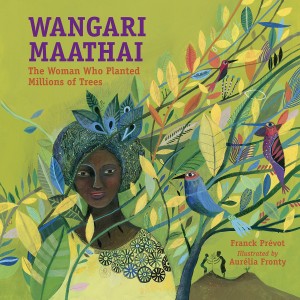
This review was published in the School Library Journal January 2015 issue.
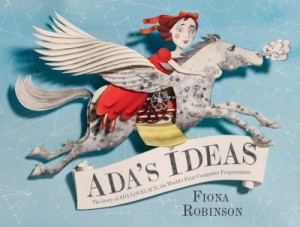 ROBINSON, Fiona. Ada’s Ideas: The Story of Ada Lovelace, the World’s First Computer Programmer. illus. by Fiona Robinson. 40p. bibliog. Abrams. Aug. 2016. Tr $17.95. ISBN 9781419718724. Gr 1-3–This latest picture book biography of Ada Lovelace is sure to captive a variety of readers. For visual learners, the illustrations (watercolors cut, arranged, and then photographed) lend the story a rhythmic movement that allows readers to better imagine the chugging of Lovelace’s Analytical Engine. The paper-doll appearance of the cast of characters evokes a sense of play around an otherwise dense subject. The text’s lilting quality will stick with aural learners long after the book is over. For example, Robinson’s citation of Lord Byron’s alliterative diminutive for his daughter—the Princess of Parallelograms—intensifies the sing-song, playful pace of the work. Despite the easy tone, Robinson celebrates Lovelace for her powerful analytical mind in spite of an overbearing mother, an absent father, and a restrictive social position. The author adeptly portrays how Lovelace’s mathematical reasoning was largely unmatched during her time, as well as how her hopeful, expansive imagining of future incarnations of the Analytical Engine led directly to modern computers. The only drawback of this work is its lack of page numbers or index, hindering classroom or homework use. VERDICT A fascinating and uplifting STEAM selection, highly recommended for biography collections.–Chelsea Woods, New Brunswick Free Public Library, NJ
ROBINSON, Fiona. Ada’s Ideas: The Story of Ada Lovelace, the World’s First Computer Programmer. illus. by Fiona Robinson. 40p. bibliog. Abrams. Aug. 2016. Tr $17.95. ISBN 9781419718724. Gr 1-3–This latest picture book biography of Ada Lovelace is sure to captive a variety of readers. For visual learners, the illustrations (watercolors cut, arranged, and then photographed) lend the story a rhythmic movement that allows readers to better imagine the chugging of Lovelace’s Analytical Engine. The paper-doll appearance of the cast of characters evokes a sense of play around an otherwise dense subject. The text’s lilting quality will stick with aural learners long after the book is over. For example, Robinson’s citation of Lord Byron’s alliterative diminutive for his daughter—the Princess of Parallelograms—intensifies the sing-song, playful pace of the work. Despite the easy tone, Robinson celebrates Lovelace for her powerful analytical mind in spite of an overbearing mother, an absent father, and a restrictive social position. The author adeptly portrays how Lovelace’s mathematical reasoning was largely unmatched during her time, as well as how her hopeful, expansive imagining of future incarnations of the Analytical Engine led directly to modern computers. The only drawback of this work is its lack of page numbers or index, hindering classroom or homework use. VERDICT A fascinating and uplifting STEAM selection, highly recommended for biography collections.–Chelsea Woods, New Brunswick Free Public Library, NJ
This review was published in the School Library Journal October 2016 issue.
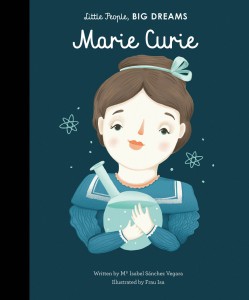 VEGARA, Ma Isabel Sánchez. Agatha Christie. illus. by Elisa Munsó. ISBN 9781847809605. ––––. Marie Curie. illus. by Frau Isa. ISBN 9781847809629. ea vol: 32p. (Little People, Big Dreams). chron. photos. Frances Lincoln. Mar. 2017. Tr. $14.99. K-Gr 3–Young readers are introduced to the exceptional lives of Agatha Christie and Marie Curie. Though slight, each book succinctly portrays its figure as a once inquisitive child eager to pursue her interests, concluding with her ultimate success. Events are selected for their relatability for child readers (a young Christie reading in bed late at night, a young Curie winning a gold medal at school). The informative text is accompanied by visuals that portray scenes relevant to the story. Christie is smartly illustrated in black-and-white with pops of red, a perfect reflection of her future as a mystery writer. Curie is steeped in cool tones, with an occasional pinkish heart surrounding Curie and her husband, Pierre. An extra bonus is the additional biographical material and photographs for each volume. VERDICT Another batch of successful installments in the series. Consider wherever the “Little People, Big Dreams” titles are popular or as an introduction to these two influential women.–Paula Huddy, The Blake School-Highcroft Campus, Wayzata, MN –Mattie Cook, River Grove PL, IL
VEGARA, Ma Isabel Sánchez. Agatha Christie. illus. by Elisa Munsó. ISBN 9781847809605. ––––. Marie Curie. illus. by Frau Isa. ISBN 9781847809629. ea vol: 32p. (Little People, Big Dreams). chron. photos. Frances Lincoln. Mar. 2017. Tr. $14.99. K-Gr 3–Young readers are introduced to the exceptional lives of Agatha Christie and Marie Curie. Though slight, each book succinctly portrays its figure as a once inquisitive child eager to pursue her interests, concluding with her ultimate success. Events are selected for their relatability for child readers (a young Christie reading in bed late at night, a young Curie winning a gold medal at school). The informative text is accompanied by visuals that portray scenes relevant to the story. Christie is smartly illustrated in black-and-white with pops of red, a perfect reflection of her future as a mystery writer. Curie is steeped in cool tones, with an occasional pinkish heart surrounding Curie and her husband, Pierre. An extra bonus is the additional biographical material and photographs for each volume. VERDICT Another batch of successful installments in the series. Consider wherever the “Little People, Big Dreams” titles are popular or as an introduction to these two influential women.–Paula Huddy, The Blake School-Highcroft Campus, Wayzata, MN –Mattie Cook, River Grove PL, IL
This review was published in the School Library Journal February 2017 issue.
Middle To High School
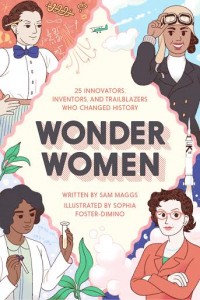 MAGGS, Sam. Wonder Women: 25 Innovators, Inventors, and Trailblazers Who Changed History. illus. by Sophia Foster-Dimino. 240p. appendix. bibliog. index. Quirk. Oct. 2016. Tr. $16.99. ISBN 9781594749254.
MAGGS, Sam. Wonder Women: 25 Innovators, Inventors, and Trailblazers Who Changed History. illus. by Sophia Foster-Dimino. 240p. appendix. bibliog. index. Quirk. Oct. 2016. Tr. $16.99. ISBN 9781594749254.
In her latest work, Maggs (The Fangirl's Guide to the Galaxy) seeks to shine the spotlight on women who changed history—and give credit back to those whose work was ascribed to their male counterparts. The book is divided into five parts, each focusing on five women from various backgrounds whose contributions made a significant impact, including Q&A's with modern, noteworthy women in specific professions. Emphasizing experts of science, medicine, espionage, innovation, and adventure, these individual profiles serve as a solid introduction to each woman featured. However, readers wishing for in-depth material on specific pioneers should merely use this work as a starting point. In a down-to-earth and often humorous tone, Maggs provides a guide to scientists such as Mary Sherman Morgan, astronomer and mathematician Wang Zhenyi, and mathematician Ada Lovelace, who advanced their fields despite societal barriers to success. VERDICT This anthology of biographies on trailblazing women is likely to draw attention from a variety of readers but will especially appeal to those interested in women's history and STEM (science, technology, engineering, and mathematics) careers.–Mattie Cook, River Grove PL, IL
This review was published in the Library Journal July 15, 2016 issue.
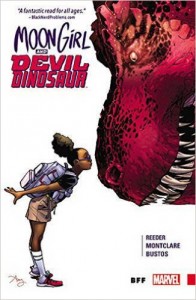 MONTCLARE, Brandon & Amy Reeder. Moon Girl and Devil Dinosaur Vol. 1: BFF. illus. by Natacha Bustos. Marvel. Jul. 2016. 136p. pap. $17.99. ISBN 9781302900052. Dating from 1978, Devil Dinosaur was friends with Moon-Boy in a prehistoric world menaced by the Killer-Folk. Now the dinosaur and a scummy gang of Killer-Folk appear in a Lower East Side neighborhood—and only preteen genius Lunella understands that the Killer Folk’s glowing Nightstone can save humanity from terrigen gas. This winning heroine with a gigantic friend, bright colors, plenty of action, and goofy situations will appeal to tweens.
MONTCLARE, Brandon & Amy Reeder. Moon Girl and Devil Dinosaur Vol. 1: BFF. illus. by Natacha Bustos. Marvel. Jul. 2016. 136p. pap. $17.99. ISBN 9781302900052. Dating from 1978, Devil Dinosaur was friends with Moon-Boy in a prehistoric world menaced by the Killer-Folk. Now the dinosaur and a scummy gang of Killer-Folk appear in a Lower East Side neighborhood—and only preteen genius Lunella understands that the Killer Folk’s glowing Nightstone can save humanity from terrigen gas. This winning heroine with a gigantic friend, bright colors, plenty of action, and goofy situations will appeal to tweens.
This article was published in Library Journal November 15, 2016 issue.
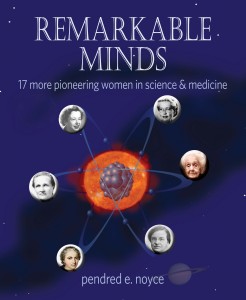 NOYCE, Pendred E. Remarkable Minds: 17 More Pioneering Women in Science and Medicine. 192p. chron. further reading. photos. Tumblehome Learning. Sept. 2015. Tr $18.95. ISBN 9780990782902. Gr 7 Up–This well-researched, interesting companion to the author’s Magnificent Minds: 16 Pioneering Women in Science and Medicine (Tumblehome Learning, 2015) adds 17 women. Examining notable figures who worked in areas as diverse as astronomy and DNA research, this exploration is a revelation. Readers may recognize Marie Curie’s equally accomplished daughter, Irène Joliot-Curie, but what of Émilie du Châtelet, who explored the worlds of mathematics and physics (and found time to delve into the world of love as well—a pastime tolerated by her often absent military husband)? Or Marietta Blau, the first to photograph cosmic rays, who was forced to abandon her research in the face of Nazi threats? Or Jane Cooke Wright, who made great strides in the field of chemotherapy? Here is a solid cadre of determined women, inspired in their approach to their chosen domains, all using their considerable talents to overcome the social expectations of their times to further knowledge. Each is awarded a lucidly written, readable biographical essay that not only delineates her research but also includes personal details that bring her to life. Each chapter is accompanied by a time line of personal experiences from the woman’s own life and of historical and world events (including dates such as the start of World War I and Charles Lindbergh’s solo flight across the Atlantic). Sidebars on relevant topics add to the appeal, and illustrations (many tiny) are liberally scattered throughout. VERDICT This scholarly look at 17 remarkable, intelligent women devoted to research in science and medicine will round out science or biography collections.–Patricia Manning, formerly at Eastchester Public Library, NY
NOYCE, Pendred E. Remarkable Minds: 17 More Pioneering Women in Science and Medicine. 192p. chron. further reading. photos. Tumblehome Learning. Sept. 2015. Tr $18.95. ISBN 9780990782902. Gr 7 Up–This well-researched, interesting companion to the author’s Magnificent Minds: 16 Pioneering Women in Science and Medicine (Tumblehome Learning, 2015) adds 17 women. Examining notable figures who worked in areas as diverse as astronomy and DNA research, this exploration is a revelation. Readers may recognize Marie Curie’s equally accomplished daughter, Irène Joliot-Curie, but what of Émilie du Châtelet, who explored the worlds of mathematics and physics (and found time to delve into the world of love as well—a pastime tolerated by her often absent military husband)? Or Marietta Blau, the first to photograph cosmic rays, who was forced to abandon her research in the face of Nazi threats? Or Jane Cooke Wright, who made great strides in the field of chemotherapy? Here is a solid cadre of determined women, inspired in their approach to their chosen domains, all using their considerable talents to overcome the social expectations of their times to further knowledge. Each is awarded a lucidly written, readable biographical essay that not only delineates her research but also includes personal details that bring her to life. Each chapter is accompanied by a time line of personal experiences from the woman’s own life and of historical and world events (including dates such as the start of World War I and Charles Lindbergh’s solo flight across the Atlantic). Sidebars on relevant topics add to the appeal, and illustrations (many tiny) are liberally scattered throughout. VERDICT This scholarly look at 17 remarkable, intelligent women devoted to research in science and medicine will round out science or biography collections.–Patricia Manning, formerly at Eastchester Public Library, NY
This review was published in the School Library Journal October 2015 issue.
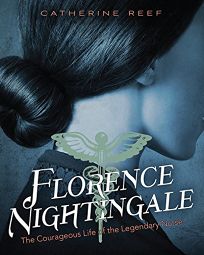 REEF, Catherine. Florence Nightingale: The Courageous Life of the Legendary Nurse. 192p. bibliog. index. notes. photos. Clarion. Nov. 2016. Tr $18.99. ISBN 9780544535800. Gr 7 Up–Born into a wealthy English family in 1820, Florence Nightingale was expected to marry and tend to the home. Nightingale, however, had different ideas and felt that she had been called to action by God. Reef’s meticulously researched biography chronicles Nightingale’s remarkable achievements. Her revolutionary approach to nursing impacted all aspects of English society, from soldiers in the army to the impoverished people suffering in workhouse infirmaries. By placing Nightingale’s life within the context of the Victorian era—a time of great colonial expansion as well as economic and scientific change—Reef highlights her subject’s unique single-minded drive to work and make a difference for the sick and infirm, despite the many obstacles she faced as a woman. Nightingale became famous during the Crimean War when she spent two years with a team of nurses under her direction caring for wounded and ill soldiers. However, her reform work began long before the war and continued until her death at age 90. VERDICT With accessible language, a linear story line, and photographs interspersed throughout, this is a great addition to any library. Recommended for students writing reports and others who want to learn about the remarkable “Lady with the Lamp.”–Ragan O’Malley, Saint Ann’s School, Brooklyn
REEF, Catherine. Florence Nightingale: The Courageous Life of the Legendary Nurse. 192p. bibliog. index. notes. photos. Clarion. Nov. 2016. Tr $18.99. ISBN 9780544535800. Gr 7 Up–Born into a wealthy English family in 1820, Florence Nightingale was expected to marry and tend to the home. Nightingale, however, had different ideas and felt that she had been called to action by God. Reef’s meticulously researched biography chronicles Nightingale’s remarkable achievements. Her revolutionary approach to nursing impacted all aspects of English society, from soldiers in the army to the impoverished people suffering in workhouse infirmaries. By placing Nightingale’s life within the context of the Victorian era—a time of great colonial expansion as well as economic and scientific change—Reef highlights her subject’s unique single-minded drive to work and make a difference for the sick and infirm, despite the many obstacles she faced as a woman. Nightingale became famous during the Crimean War when she spent two years with a team of nurses under her direction caring for wounded and ill soldiers. However, her reform work began long before the war and continued until her death at age 90. VERDICT With accessible language, a linear story line, and photographs interspersed throughout, this is a great addition to any library. Recommended for students writing reports and others who want to learn about the remarkable “Lady with the Lamp.”–Ragan O’Malley, Saint Ann’s School, Brooklyn This review was published in the School Library Journal September 2016 issue.
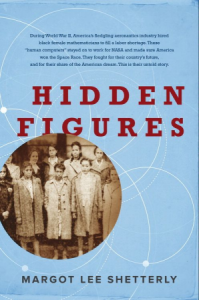
This review was published in the School Library Journal April 2017 issue.
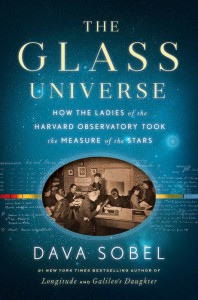 SOBEL, Dava. The Glass Universe: How the Ladies of the Harvard Observatory Took the Measure of the Stars. 336p. bibliog. chron. ebook available. glossary. index. Viking. Dec. 2016. Tr $30. ISBN 9780670016952. Gr 9 Up–Railroad heiress Anna Draper was introduced to a love of the stars by her husband, Dr. Henry Draper, whose stellar photography was recognized throughout the United States. After his death, Anna Draper wished to continue his work photographing stars and reached out to one of his many prominent scientific colleagues, Edward Pickering, a professor at the Harvard College Observatory. Henry Draper’s work reflected the changes in the late 1800s in the field of astronomy as advancements in photography improved the quality of stellar images. As technology progressed, more people were needed to analyze and preserve the images. The Harvard College Observatory expanded their staff (previously only men) to include the wives and other family members of the astronomers working at Harvard; eventually graduates of women’s colleges such as Vassar, Radcliffe, and Wellesley were employed as well. The women were originally hired as human calculators, but their roles grew to encompass cataloging the images as well as participating in the astronomical studies conducted by the male astronomers. Over time, the women’s contributions to the field of astronomy ranged from identifying new stars to developing a stellar classification system that is still in use today. Relying on primary source materials such as letters and memoirs, Sobel crafts a story that illuminates the crucial role women played in the scientific community. VERDICT Teens interested in astronomy and the recent Hidden Figures will be fascinated by the work and discoveries made by these ambitious and talented women.–Lynn Rashid, Marriotts Ridge High School, Marriottsville, MD
SOBEL, Dava. The Glass Universe: How the Ladies of the Harvard Observatory Took the Measure of the Stars. 336p. bibliog. chron. ebook available. glossary. index. Viking. Dec. 2016. Tr $30. ISBN 9780670016952. Gr 9 Up–Railroad heiress Anna Draper was introduced to a love of the stars by her husband, Dr. Henry Draper, whose stellar photography was recognized throughout the United States. After his death, Anna Draper wished to continue his work photographing stars and reached out to one of his many prominent scientific colleagues, Edward Pickering, a professor at the Harvard College Observatory. Henry Draper’s work reflected the changes in the late 1800s in the field of astronomy as advancements in photography improved the quality of stellar images. As technology progressed, more people were needed to analyze and preserve the images. The Harvard College Observatory expanded their staff (previously only men) to include the wives and other family members of the astronomers working at Harvard; eventually graduates of women’s colleges such as Vassar, Radcliffe, and Wellesley were employed as well. The women were originally hired as human calculators, but their roles grew to encompass cataloging the images as well as participating in the astronomical studies conducted by the male astronomers. Over time, the women’s contributions to the field of astronomy ranged from identifying new stars to developing a stellar classification system that is still in use today. Relying on primary source materials such as letters and memoirs, Sobel crafts a story that illuminates the crucial role women played in the scientific community. VERDICT Teens interested in astronomy and the recent Hidden Figures will be fascinated by the work and discoveries made by these ambitious and talented women.–Lynn Rashid, Marriotts Ridge High School, Marriottsville, MD
This review was published in the School Library Journal April 2017 issue.
Professional Reading
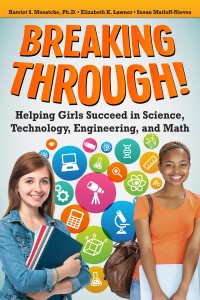 Mosatche, Harriet S., Elizabeth Lawner, & Susan Matloff-Nieves. Breaking Through!: Helping Girls Succeed in Science, Technology, Engineering, and Math. 296p. bibliog. Prufrock. Feb. 2016. pap. $16.95. ISBN 9781618215215.
Mosatche, Harriet S., Elizabeth Lawner, & Susan Matloff-Nieves. Breaking Through!: Helping Girls Succeed in Science, Technology, Engineering, and Math. 296p. bibliog. Prufrock. Feb. 2016. pap. $16.95. ISBN 9781618215215.
While the knowledge that women are underrepresented in STEM careers is not earth-shattering, the research rounded up in this book might shock readers not already familiar with the depth of the gender gap. Delving into past and current research about girls and STEM, the authors break down societal stereotypes about innate vs. learned abilities and the lack of female interest in STEM activities, demonstrating how girls can be pushed away from typically male-heavy fields. Additional research about role models and mentoring programs elucidates ways in which adults can effectively support young women interested in these pursuits. Advocacy advice provides parents and caring adults with various methods for guiding girls toward STEM and creating receptive environments so that they aren’t shunned, overlooked, or ignored by peers or adults. Perhaps the most valuable aspect of this title is the quick-start guide for incorporating STEM into everyday life. The suggested activities and recommended discussions of scientific method and creative problem-solving appropriately coach adults to feel comfortable talking with and advising girls to become involved in STEM paths for many years to come. Parents, educators, and librarians will all find ideas to implement in this thorough resource. VERDICT A recommended purchase for most parenting, professional reading, or reference collections.
This review was published in the School Library Journal July 2016 issue.
The job outlook in 2030: Librarians will be in demand
The job outlook in 2030: Librarians will be in demand
ALREADY A SUBSCRIBER? LOG IN
We are currently offering this content for free. Sign up now to activate your personal profile, where you can save articles for future viewing






Add Comment :-
Be the first reader to comment.
Comment Policy:
Comment should not be empty !!!